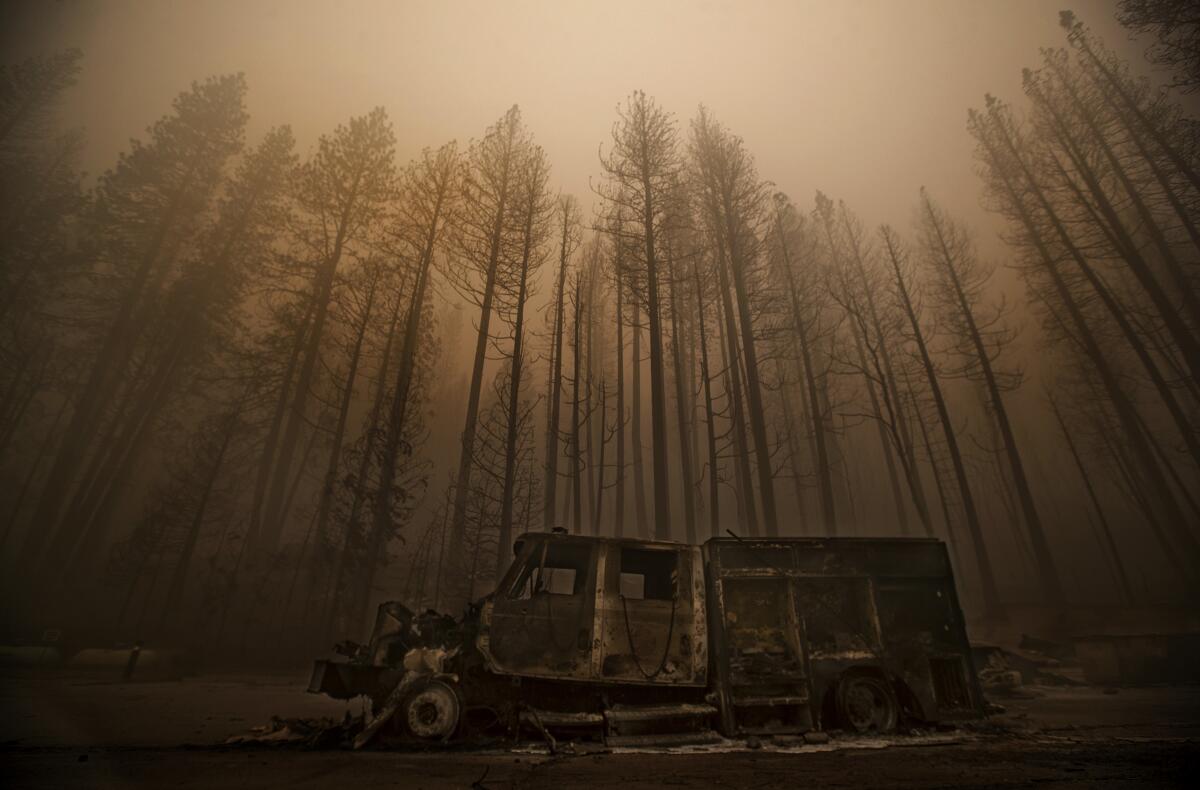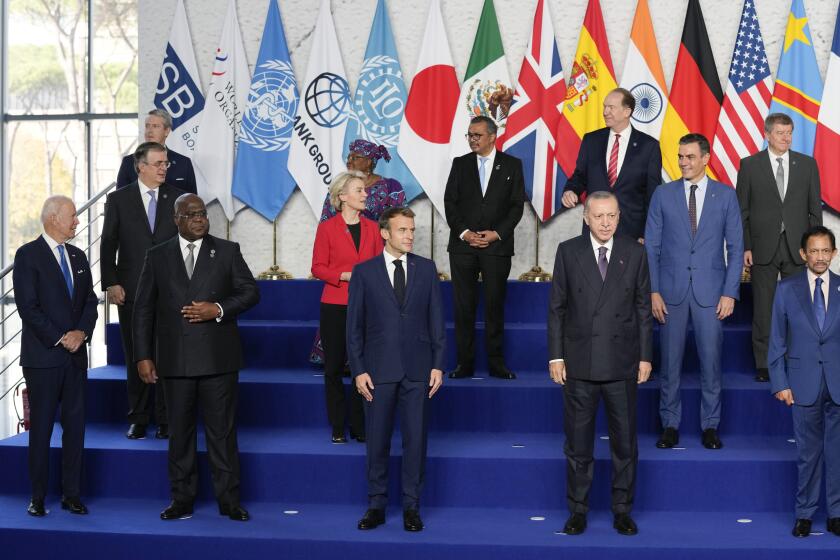Climate change is now the main driver of increasing wildfire weather, study finds

- Share via
In a finding that scientists believed was still decades away from becoming reality, California researchers say that climate change is now the overwhelming cause of conditions driving extreme wildfire behavior in the western United States.
As world leaders gathered in Scotland this week to discuss plans to reduce greenhouse gas emissions, a study released on Monday said that global warming was essentially two-thirds to 88% responsible for the atmospheric conditions fueling increasingly destructive wildfires.
And that’s a conservative estimate, said study author Rong Fu, a climate researcher at UCLA.
“It’s happened so much faster than we previously anticipated,” she added.
The study, published this week in the Proceedings of the National Academy of Sciences, looks at what’s known as the vapor pressure deficit, which basically describes how thirsty the atmosphere is, Fu said.
The researchers found this to be the leading meteorological variable that controls how much land burns in the western U.S. during a given fire season. The higher the deficit, the more moisture the atmosphere saps from soil and plants, priming the landscape to burn.
Previous studies have found the atmosphere in the western U.S. has grown thirstier over the last 40 years. Experts have theorized that is due to natural fluctuations in the weather and because carbon dioxide emissions have caused the planet to warm, and warmer air can hold more moisture.
This team of researchers, which included scientists from UCLA and the Lawrence Livermore National Laboratory, sought to explain exactly how much of each of those factors has driven the increase. They used a machine learning approach to compare recent vapor pressure deficit values with those observed in the past during similar weather patterns.
“Prior to 2000, we can explain this fire weather pretty well just using the weather patterns,” Fu said. “But now we can only explain like 30% of what we see with the fire weather.”
After ruling out other influences such as changes in vegetation and cloud cover, the researchers concluded the remaining 70% is due to greenhouse gases warming the planet, she said, a figure that some climate modeling suggested could be as high as 88%.
The G-20 summit struggled to make progress on key issues. Biden blames the absences of Russia and China for the inaction.
The findings have important implications for fire management. If natural weather cycles were driving the increase in fire danger, it could be expected to lessen again at some point. But the planet is expected to continue to warm, meaning the risk will probably only increase, Fu said.
“This new research, combined with what we’ve known before, means that we can be very confident that continued global warming will continue to intensify the conditions that create these record or near-record fuel aridity conditions on the landscape,” said Noah Diffenbaugh, a climate scientist at Stanford University who was not involved with the study. “And we know from recent years what that means for our fire preparation and response system. It means a higher risk of more severe fire conditions, simultaneously, in multiple areas of the region.”
That fits with what fire officials have been seeing on the ground, said Jon Heggie, a battalion chief with the California Department of Forestry and Fire Protection.
“We look at temperatures and burn indexes and days where we’re in high fire danger,” he said. “And they definitely have increased — there’s no denying that.”
Over the last seven years or so, vegetation has become more combustible as summers have grown longer, hotter and drier, resulting in busier, more dangerous fire seasons marked by larger, more intense and faster-moving blazes, Heggie said. It’s no longer uncommon for a fire to burn 20,000 acres in a single day, a feat that in the past would have typically taken two weeks, he said.
“What was unprecedented before is now normal,” he said. “And we’re seeing that it wasn’t a one-off for a few years. It’s happening every year.”
Fire agencies have had to pivot to new ways of fighting and preventing fires in this changed environment. They include everything from adopting new technologies such as drones and night-flying helicopters to redoubling efforts to focus on fuels management and community outreach and education.
“We are at the dawn of this new era of firefighting, and we are still looking for opportunities to address this growing issue,” Heggie said.
Wildfires have burned nearly 2.5 million acres in California this year, choking the region with dismal air quality that has at times reached across the continent. This year’s total is second only to last year, when more than 4.1 million acres burned.
Nearly a quarter of that acreage was scorched by the August Complex fire, which was sparked by a siege of dry lightning strikes Aug. 16, 2020, and went on to become the largest fire in state history. The vapor pressure deficit over a large area of the western U.S. that day was the highest value measured over the last 40 years, Fu said.
When researchers compared that with similar weather patterns in the past, they could explain only about 60% of the above-normal value, she said.
Conditions were similarly extreme during last year’s Creek fire, which burned in the Sierra National Forest, and researchers could explain only about 40% of the departure from normal, Fu said.
“So when we consider the weather pattern that happened during those days, we only can explain about half of the above-normal vapor pressure deficit value,” she said. They attribute the other half to climate change, she added.
The researchers’ estimate on the effects of climate change is conservative because they did not take into account its role in shifting the weather patterns themselves, Fu said. For instance, some studies have suggested that global warming is altering the strength and frequency of certain high pressure ridging patterns that result in critical fire weather, but these researchers assumed that all changes in weather patterns were natural, she said.
They also found that the effects of climate change have been coming on more rapidly than some predicted. The researchers initially expected that human-caused warming would not outpace natural climate variability in driving fire weather until later in the 21st century, for example after 2080, Fu said.
“But now, we’re seeing even in the first 20 years of the 21st century, the greenhouse-gas-induced fire weather has already surpassed natural variability,” she said. “This is a lot faster than we were expecting, at least in the western U.S. for fire.”
Only four heads of state from Pacific island nations can attend the climate summit.
While other researchers said that did not represent much of a departure from their past projections, they agreed that the effects of climate change are accelerating faster than society is equipped to deal with.
“What is very clear is that the gap between what is happening and what we’re prepared for is much larger than the gap between what is happening and what was predicted,” Diffenbaugh said.
California has had a front-row seat to this rapid shift. Just this year, the state reported its hottest summer on record, its driest water year in nearly a century and its second-largest wildfire: the Dixie fire, which scorched more than 960,000 acres in Northern California.
“We certainly in the last couple years have seen some really record-shattering extreme events,” said Deepti Singh, an assistant professor in the School of the Environment at Washington State University who was not involved in the study. “And while they are surprising when they do occur, they’re pretty consistent with our knowledge and our understanding of how climate responds to increased greenhouse gases.”
Still, she said, the knowledge imparted by the study is powerful because it indicates that human activities play a key role in determining future fire risk, and that the risk could someday be reduced if the world changes trajectories to rely less on fossil fuels.
“The fire risk in this region is going to be proportional to how much the Earth warms,” she said. “And how much the Earth warms is dependent on how society decides to progress in terms of emissions.”
More to Read
Toward a more sustainable California
Get Boiling Point, our newsletter exploring climate change, energy and the environment, and become part of the conversation — and the solution.
You may occasionally receive promotional content from the Los Angeles Times.













